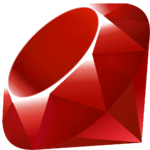
Ruby is an interpreted, object-oriented programming language. Its creator, Yukihiro Matsumoto, a.k.a “Matz”, released it to the public in 1995. Its history is covered here. Its many features are listed here.
The book is currently broken down into several sections and is intended to be read sequentially. Getting started will show how to install and get started with Ruby in your environment. Basic Ruby demonstrates the main features of the language syntax. The Ruby language section is organized like a reference to the language. Available modules covers some of the standard library. Intermediate Ruby covers a selection of slightly more advanced topics. Each section is designed to be self contained.
Table of Contents
Getting started
Basic Ruby
- Hello world
- Strings
- Alternate quotes
- Here documents
- ASCII
- Encoding
- Introduction to objects
- Ruby basics
- Data types — numbers, strings, hashes and arrays
- Writing methods
- Classes and objects
- Exceptions
Ruby Semantic reference
- Syntax
- Lexicology
- Variables and Constants
- Literals
- Operators
- Control Structures
- Methods
- Classes
- Class Definition
- Declaring Visibility
- Inheritance
- Mixing in Modules
- Ruby Class Meta-Model
- Ruby Hooks add the ability to know when new methods are defined et al.
See also some rdoc documentation on the various keywords.
Built in Classes
This is a list of classes that are available to you by default in Ruby. They are pre-defined in “core.”
- Built-in Functions
- Predefined Variables (globals)
- Predefined Classes
Available Standard Library Modules
These are parts of Ruby that you have available (in the standard library, or via installation as a gem).
To use them you typically have to require some filename, for example require 'tracer' would make accessible to you the Tracer class.
You can see a list of basically all the (std lib ruby) modules available in the ruby source and lib readme. There are a several more modules available in the std lib, which are C based extensions. You can see their list here.
- BigDecimal gives you a way to have arbitrary precision Decimal style numbers. Never succumb to rounding errors again!
- Debugger gives you a way to step through debug your Ruby code.
- Distributed Ruby (DRb) gives you a way to make remote procedure calls against objects in a different VM.
- mkmf is a utility used to generate makefiles for ruby extensions.
- Mutex gives you a way to control thread concurrency.
- Net::HTTP gives you a way to download web pages.
- Open3 gives you a way to run a sub-process and have easy access to its I/O.
- OpenSSL is a wrapper to the OpenSSL (C) library, giving you access to secure socket connections.
- Pathname gives you an easy way to manipulate filenames and create/remove files.
- Profiler gives you a way to profile what is taking up the most time in your code.
- OpenURI gives you a way to download files using ruby.
- REXML is a way to parse XML in pure Ruby.
- Ripper gives you a way to parse pure Ruby code into an AST.
- Socket gives you access to Network connectivity.
- Tracer gives you a way to see which lines of your code are being executed and in what order.
- Win32::Registry gives you a way to query and edit the windows registry.
- Win32API gives you a way to call into specific windows core methods easily.
- WIN32OLE gives you a way to use Windows OLE.
Other Libraries
GUI Libraries
- GUI Toolkit Modules gives a run down of various options for ruby GUI programming.
Here is info on some specifically:
Intermediate Ruby
Here are some more in depth tutorials of certain aspects of Ruby.
- Unit testing
- RubyDoc
- Rake
- RubyGems
- Running Multiple Processes
- Using Network Sockets
- Building C Extensions
- Rails
- Embedding Ruby within a separate C program
External links
- Ruby homepage
- Access to various Ruby mailing lists
- Ruby Talk FAQ
- RubyForge: The Repository for Open-source Ruby Projects
- a place where people vote on things they like most per category
Documentation
Core Docs
- Ruby Documentation Homepage - various ruby documentations and tutorials, as well as information on how to update ruby's core docs should you so desire.
- webri ruby core api as a webri
gem docs
- “rdoc.info”:http://www.rdoc.info yard rdoc’s for gems hosted on github
- “ruby toolbox”:http://ruby-toolbox.com list of gems by popularity
Learning Ruby
- Try Ruby - learn the basics of the Ruby language in your browser.
- LearnStreet - Free online Ruby tutorials & practice exercises
- A Ruby Tutorial that Anyone can Edit (broken)
- Learning Ruby A free tool to find and learn Ruby concepts
Books
- The Ruby Programming Language by David Flanagan, Yukihiro Matsumoto aka “Matz,” the creator of Ruby. Also covers 1.9
- Programming Ruby 3 (aka “Pickaxe”) — this 2009 version covers Ruby 1.9
- Ruby by Example
Online
- Programming Ruby (a.k.a. “Pickaxe”) 1st edition online version
- Ruby Study Notes
- Why’s (Poignant) Guide To Ruby
- Humble Little Ruby Book
- Ruby Hacker’s Guide is a guide to the guts of (mostly 1.8) ruby, translated from its original Japanese.
Quick References
- Ruby Quick Reference (some of more obscure expressions are explained)
- Ruby Cheat Sheets (a list of some different Ruby cheat sheets)